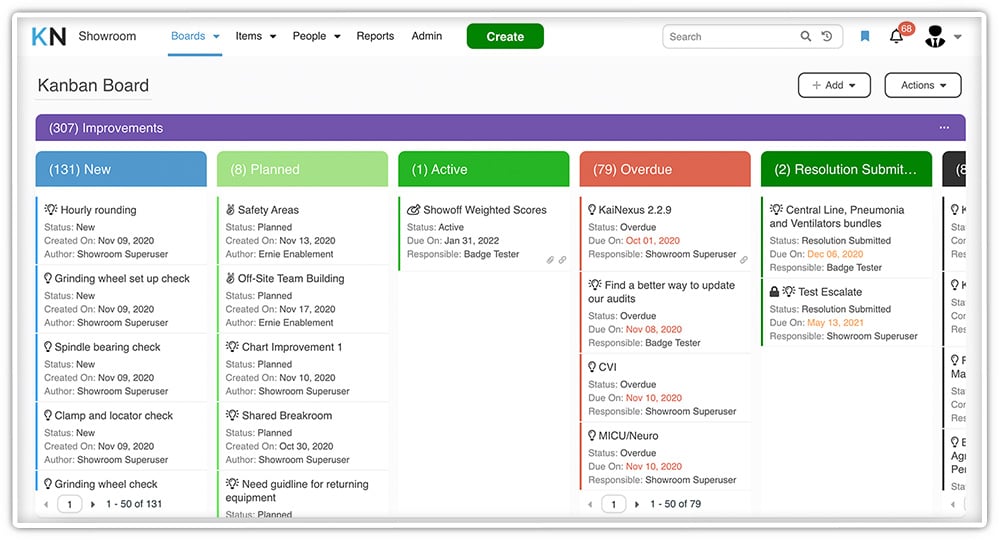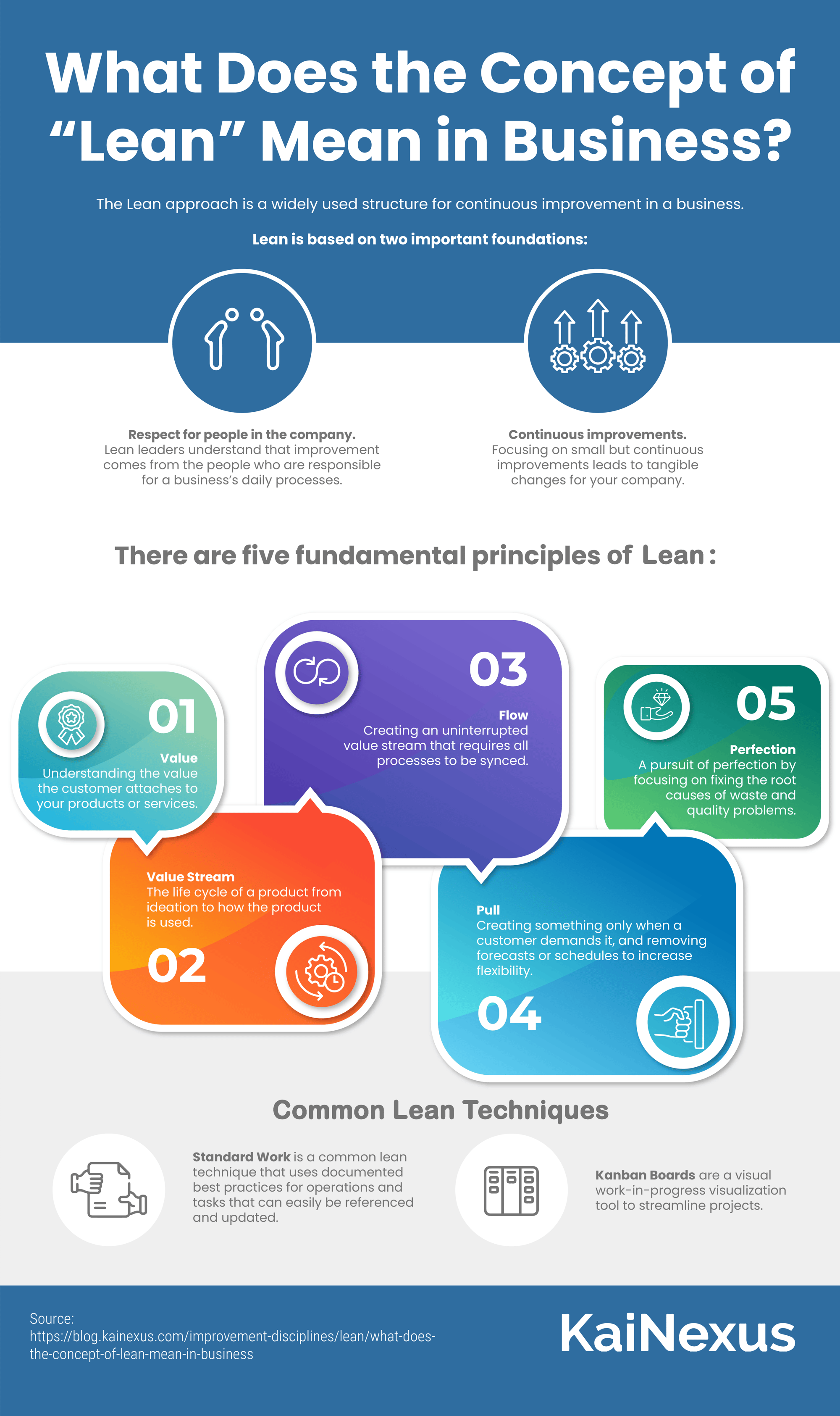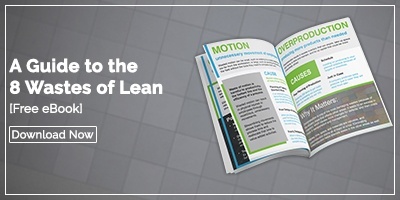 The modern business landscape is full of buzzwords and passing management fads, so it isn't surprising if you hear of a new "methodology" and just let it go in one ear and out the other. However, it's a good idea to make an exception for Lean business management. The Lean approach is one of the most widely used structures for continuous improvement worldwide for good reasons. It is practical, relatively easy to implement, and flexible enough to support businesses of all types.
The modern business landscape is full of buzzwords and passing management fads, so it isn't surprising if you hear of a new "methodology" and just let it go in one ear and out the other. However, it's a good idea to make an exception for Lean business management. The Lean approach is one of the most widely used structures for continuous improvement worldwide for good reasons. It is practical, relatively easy to implement, and flexible enough to support businesses of all types.
The Foundations of Lean
Lean business management is an adaptation of the Toyota Production System that the Japanese automaker implemented after the second world war to improve the efficiency and flexibility of its manufacturing operations. Two essential books, Lean Thinking (1996) by James P. Womack and Daniel T. Jones, and The Machine That Changed the World (1990) by James P. Womack, Daniel Roos, and Daniel T. Jone, documented the techniques and principles of the Lean method.
Although Lean management started in manufacturing, today it is widely used for operational improvement across the world in every industry, including transportation, professional services, retail, healthcare, construction, maintenance, and software development.
Two fundamental ideas guide Lean management. To practice Lean, an organization must embrace both.
1. Respect for People
Lean leaders know that the best ideas for improvement come from the people who are directly responsible for operating a process or providing a service. So lean takes the opposite approach from top-down management by giving those closest to the customer or product an equal voice in improvement work.
2. Continuous Improvement
The Lean methodology is focused on implementing minor improvements continuously as part of the goal of perfection. Big ideas and new products are great, but daily incremental improvements are the key to long-term operational excellence and profitability.
Lean Principles
Jones and Womack identify five fundamental Lean management principles, giving leaders an operational framework.
1. Value
The jumping-off point for implementing Lean is understanding the value the customer attaches to the product or service. The customer continually defines value, not the producer. The price the customer is willing to pay determines the maximum allowable expense to create the product. Once the value is understood, the organization focuses on reducing waste to deliver what the customer wants with the highest amount of profit.
2. The Value Stream
The value stream is the complete picture of the product's life cycle from ideation to the customers' use of the product. Understanding the value stream is the first step in maximizing value and eliminating waste. Next, every process, task, and raw material is assessed to see its value to the customer. Finally, anything that doesn't add value is targeted for elimination if possible.
3. Flow
The goal of Lean is to create a value stream that flows seamlessly without any delay or interruption. Of course, this requires that every process sync with every other. The result of a smooth process flow is just-in-time production.
4. Pull
Seamless flow is made possible by the concept of pull. Pull means that nothing is created before the customer demands it. The idea of pull applies to both internal and external customers. For example, forecasts or schedules do not drive a Lean organization. Instead, nothing is made until the external or internal customer orders it. This approach allows for shorter delivery cycle times and increased flexibility.
5. Perfection
Lean is about the relentless pursuit of perfection. But unfortunately, workarounds and Band-aids are not the paths to perfection. Only by understanding the root causes of waste and quality problems can perfection ever be achieved.
Lean Waste
To make waste easier to identify and remove, the Lean methodology puts it into eight categories:
1. Motion
Motion is wasted when movements of materials, people, or machines are more complex or frequent than necessary.
2. Transportation
Similarly, transportation is wasted when materials or people are moved from one place to another without adding value for the customer.
3. Inventory
Inventory is wasted when items are created or stored before they are needed to fulfill customer demand.
4. Waiting
The waste of waiting is the result of interrupted flow or out-of-sync processes. People or processes waiting for inputs can not produce value.
5. Defects
Defects and rework are the most obvious form of waste and result in the waste of materials, time, and human resources.
6. Overproduction
When more work-in-progress is produced than needed, the result is often the wastes of inventory, transportation, and motion.
7. Over-processing
Over-processing occurs when more work, features, or cost is added to the product than the customer demands.
8. Human Potential
Human potential is wasted when a person's capabilities, creativity, and point of view are underutilized.
Lean Techniques
Many tools and techniques have been developed to support the Lean approach.
Standard Work
Standard Work forms the basis for all improvement activities. It is the documented current best practice for any process operation or task. Standard work is created and maintained by the process operators. It must be complete, available in the workspace, constantly applied, and always up to date. Whenever a successful improvement is implemented, process operators update the standard work.
PDSA
PDSA is an improvement cycle that stands for Plan, Do, Study, Adjust. Although the idea is simple, it helps create consistency and structure for improvement projects:
Plan: Define the problem, measure performance indicators, and consider potential solutions:
Do: Implement one improvement idea at a time.
Study: Measure the results of the changed process vs. the performance measurements.
Adjust: If the change resulted in improvement, update the Standard work documentation to include it. If not, select a new potential solution.
Kanban Boards
Kanban boards are a common Lean tool for visualizing work-in-progress to ensure no interruptions inflow or pull. Each work element is placed on a card that is moved from one column to the next as the related process or person needs it. The practice makes it easy to see where there are backlogs or tasks waiting for inputs.

Lean Software
Not all organizations that practice Lean use software to support it, but those that do have found it accelerates improvement, helps prove an ROI for Lean, and increases employee engagement. Most solutions are organized around these critical features.
Capture Ideas for Improvement
Lean improvement projects begin with employee ideas, so it is essential to have an easy way to collect and manage them. Ideally, the solution is cloud-based and available 24x7 from anywhere. In addition, mobile apps can increase employee engagement by making it possible to suggest an idea right from the device they already use.
Implement Improvements
One of the reasons organizations are ditching email and spreadsheets in favor of Lean software is that it provides active notifications and alerts. The right people are notified when an idea is submitted for review. Once a project is underway, everyone who needs them can get email alerts when a task is due or completed.
Develop Tribal Knowledge
By managing improvement activities in a central location, the organization gains a robust repository of information and insight. Before a project commences, the user can search the systems to see if something similar has been tried before and build on that experience.
Measure and Report Results
The best way to get everyone from the C-suite to the front line excited about Lean is to implement a few projects and measure the results. When people see objective improvement to key metrics like cost, customer satisfaction, safety, quality, and time to market, they are more likely to engage and provide the resources to do even more.
Leaders that invest the effort to implement a Lean structure and a culture that supports continuous improvement put their organization in the best position to achieve market success and stability.





Add a Comment